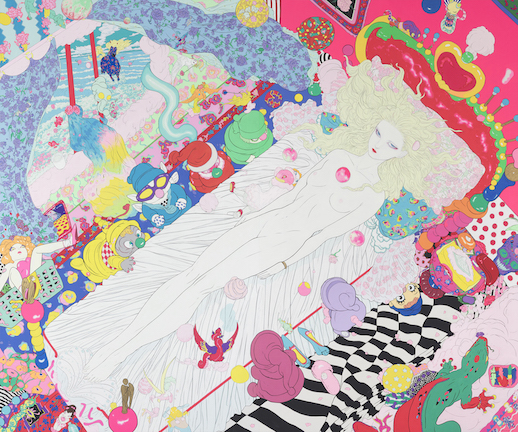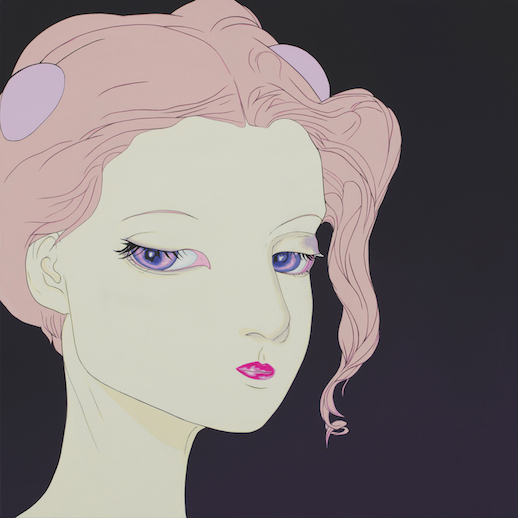Spring Dreaming

In his latest exhibition, “Tales of Spring Dreams” currently at Mizuma Art Gallery, Amano’s subjects are young women on the cusp of adulthood. In place of the wispy lines of his Final Fantasy artwork, you’ll find block colors and shiny surfaces à la Superflat. With car paint as a medium, a nod to consumer culture is also appropriate to Takashi Murakami’s movement. Most suggestive of Superflat is the exhibition’s centerpiece “Spring Awakening,” a massive, technicolor depiction of a girl lying prone in a cluttered room. Automotive paint and acrylic on an aluminum panel, the work commands immediate attention on entering the gallery. Devoid of the usual delicacy that accompanies spring motifs, “Spring Awakening” is so cluttered and colorful it borders on kitsch. The other paintings in the main room, a series of portraits with titles like “Lady Blue,” “Lady Red” and “Lady Mint Green” are far less busy. These works are a clear continuation of Amano’s “Candy Girl” series, which was used in collaborations with brands in 2016 to create high-end merchandise for an event at Mitsukoshi Ginza department store. “Candy Girl” is a big-eyed, hyper-expressive girl of around 16, depicted with bright colors and a futuristic bent. In “Tales of Spring Dreams,” the subjects have aged a few years but maintain some of Candy Girl’s distinguishing features, such as the round antennae on the sides of their heads.

“Tales of Spring Dreams” would almost be a comfortable middle road between romantic escapism and undisguised consumerism if it weren’t for the destabilizing effect of Mizuma Art Gallery’s side room and the works within. Adjacent to the main room is a small chamber containing a Japanese-style room with rare black tatami mats. This layout has led to some interesting curatorial choices in many of Mizuma’s exhibitions, and “Tales of Spring Dreams” is no exception. In this space, you’ll find six out of seven of the “Lady Noir” paintings – young women depicted in the sumi-e style of East Asian ink brush painting. Although the subjects are the same as the rest of the exhibition, the dramatic monochrome brush strokes could not be more different from the shiny automotive paint. The overall impact is odd, jagged, and raises more questions than it answers. Lady Noir saves “Tales of Spring Dreams” from prettiness and predictability; her murmurings of Japanese tradition through blurry dark ink are suggestive without prescribing a fixed meaning.
Yes, the default equation of very young women to the “fleeting beauty of spring” seems unoriginal at best, phallogocentric at worst. Then again, Yoshitaka Amano has not built his career on the strength of his message but his undeniable aesthetic mastery. “Tales of Spring Dreams” is gorgeous and playful, with a hint of the ominous and jagged edges to maintain the viewer’s attention. Fans of sci-fi, fantasy, Superflat, and traditional fine art alike, as well as newcomers to Amano’s work, will find much to enjoy at this free exhibition that runs until May 18th. Tokyo Art Beat discussed the artist’s intentions with Yoshitaka Amano himself.

Interview with Yoshitaka Amano
You started your career in animation and many people know you from your work with Final Fantasy. Video games and anime are considered to be “popular culture” whereas exhibitions in a gallery like Mizuma are “fine art.” What is the difference for you?
For the popular culture works, the work I do is delivered to the viewer in the form of a game, anime, or book after it has undergone some editing. On the other hand, for fine art, I have no limitations on what I produce and what is presented is the work as I drew it. So the entrance and exit points of the works may differ, but there is not too much of a difference in the actual drawing process.
The title of the exhibition is “Tales of Spring Dreams” but there aren’t many overt references to spring in most of the works. The focus seems to be on the subjects: young women. What is the reason behind the title? How do these paintings of young women relate to spring?
Each season possesses its own color-based characteristic; spring’s striking features are its warmth, softness and the idea of change. For Japanese people, “spring dreams” represent a sense of fleetingness, but I feel that this fleetingness is both beautiful and alluring. The subjects of this exhibition, young women in the midst of maturing, are fleetingly beautiful just like a spring dream. This idea overlaps with the change of the imperial era that is occurring over this year’s spring, which brings with it its own sense of expectation and nostalgia.
A lot of the subjects have an uninterested, almost disdainful expression. Why?
Clear expressions restrict the imagination of the viewer, so I tried to keep any emotion to a minimum.
The exhibition contains two types of art: brightly colored works with automotive paint and sumi-e style monochrome works. The contrast is particularly striking because Mizuma has placed the bright paintings in the main gallery and the dark paintings in the side room. Why are these two different styles in the same exhibition?
I wanted to paint the same subjects using two different mediums. I haven’t really presented many works which use traditional Japanese paper and ink before, but by adding colors aside from just black, I tried to link the two parts of the exhibition.
The subjects in “Candy Girl” are aged around 15 or 16, whereas in “Tales of Spring Dreams” they are around 19 or 20. Why did you choose to have them grow up? Does this mean you will paint women in their late 20s for the next exhibition?
The women I painted for this exhibition is closer to what I usually draw, whereas the young girls in “Candy Girl” are more of the exception for me. I have another future series of large works featuring princesses scheduled to be released. Maybe this will bring an opportunity to paint older queens, too.
Interview by Julia Mascetti
Translated by Arthur Reiji Morris



